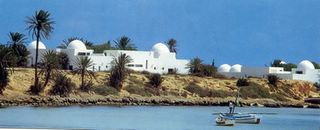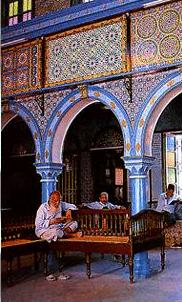The Isle of Forgetfulness
According to Greek mythology, the island of Djerba, situated off the southern coast of Tunisia, not far from the Libyan border, was the home of the seductive lotus eaters. In Homer's Odyssey, Ulysses almost lost his men when the beautiful maidens of the island fed them the lotus flower. The men were so pleasantly intoxicated by the lotus that Ulysses found it almost impossible to make them return to their ships.

This mosaic from Dougga (Tunisia) illustrates a theme borrowed from the fable. The Greek hero Ulysses, sailing by the rock of the sirens, figures represented as half-woman, half-bird. He is standing on the deck with his hands tied to the mast to prevent himself from succumbing to temptation.
Ca. AD 260 (Bardo Museum).
Some still wonder why this island, which travelers have labeled, 'Isle of Forgetfulness', holds visitors under its spell, is virtually unexplainable. A great many attribute it to its magic halo - a combination of a clear-blue sky, shining white houses, clean and well-kept towns, tree-covered countryside and warm, yet not too hot climate.

Island of Djerba
Djerba is also home for the most ancient Jewish community in Tunisia. According to legend, Jews have resided in Tunisia since the destruction of the First Temple in Jerusalem, in 586 BCE. While this cannot be substantiated by historical evidence, it is known that Tunisia was home to the most important center of Jewish life in North Africa during the period of the Roman Empire.
Various accounts are given of the origins of Jewish settlement in Djerba. The popular version is that following the destruction of the First Temple in Jerusalem, a group of priests (Cohanim) found their way to Djerba. They carried with them one of the gates of the destroyed Temple, and set it in the foundation of the synagogue they built in Djerba called the Ghriba Synagogue (el Ghriba). Thus, they preserved the memory of the Temple within the very fabric of their own synagogue.

Ghriba Synagogue
Djerba is comprised of two major groups: the Cohanim, who were the original Jewish residents in the Hara Sghira (small quarter) of Djerba, and the B'nai Yisrael (Tribes of Israel) community comprised of Jews who originated in Tunisia, Libya and Morocco, and live in the Hara Kebira (large quarter). Some Cohanim later moved to the Hara Kebira and constructed a synagogue known as the Cohanim De'getiyah (those who belong to the door) Synagogue.
The Ghriba Synagogue is considered a pilgrimage site throughout North Africa.

This mosaic from Dougga (Tunisia) illustrates a theme borrowed from the fable. The Greek hero Ulysses, sailing by the rock of the sirens, figures represented as half-woman, half-bird. He is standing on the deck with his hands tied to the mast to prevent himself from succumbing to temptation.
Ca. AD 260 (Bardo Museum).
Some still wonder why this island, which travelers have labeled, 'Isle of Forgetfulness', holds visitors under its spell, is virtually unexplainable. A great many attribute it to its magic halo - a combination of a clear-blue sky, shining white houses, clean and well-kept towns, tree-covered countryside and warm, yet not too hot climate.

Island of Djerba
Djerba is also home for the most ancient Jewish community in Tunisia. According to legend, Jews have resided in Tunisia since the destruction of the First Temple in Jerusalem, in 586 BCE. While this cannot be substantiated by historical evidence, it is known that Tunisia was home to the most important center of Jewish life in North Africa during the period of the Roman Empire.
Various accounts are given of the origins of Jewish settlement in Djerba. The popular version is that following the destruction of the First Temple in Jerusalem, a group of priests (Cohanim) found their way to Djerba. They carried with them one of the gates of the destroyed Temple, and set it in the foundation of the synagogue they built in Djerba called the Ghriba Synagogue (el Ghriba). Thus, they preserved the memory of the Temple within the very fabric of their own synagogue.

Ghriba Synagogue
Djerba is comprised of two major groups: the Cohanim, who were the original Jewish residents in the Hara Sghira (small quarter) of Djerba, and the B'nai Yisrael (Tribes of Israel) community comprised of Jews who originated in Tunisia, Libya and Morocco, and live in the Hara Kebira (large quarter). Some Cohanim later moved to the Hara Kebira and constructed a synagogue known as the Cohanim De'getiyah (those who belong to the door) Synagogue.
The Ghriba Synagogue is considered a pilgrimage site throughout North Africa.
Every May several thousand Sepharadic Jews from around the world make a pilgrimage to Ghriba to celebrate the Jewish holiday of Lag B'Omer. The dormitories and dining halls on the grounds of the synagogue become filled with pilgrims, revelers and students drinking bokha, a local fig liquor, and eating barbecued meat. Led by Raoul Journou, a famous Tunisian Jewish musician whose songs are played at every wedding and circumcision celebration, regardless of the participant's religion, an exuberant crowd walks to the nearby village of Hara Sghira. The procession then returns to Ghriba for more music, food and festivities.There are five rabbis in Tunisia; there are even several kosher restaurants in Tunis and on Djerba, which has been an active, practicing Jewish community for over two millennia, where most of the community members observe Jewish dietary laws (kashrut).




1 Comments:
Thanks for sharing this piece. I enjoyed it enormously and learned quite a bit--enough to consider going to the Isle.
Post a Comment
<< Home